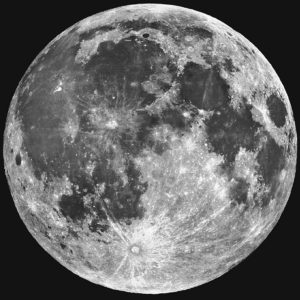Beginning around mid-month, Earth’s one and only natural satellite will appear in the evening sky. Then, as the days run down to the end of the year, the Moon will be higher and higher after each evening’s sunset, swinging from low in the west, to high overhead, to low in the east.
As you watch the Moon, you see it go through phases — when you read this it will be waxing from a thin crescent to glorious fullness by Dec. 29. It’s difficult to explain lunar phases by writing or talking. Diagrams are best, and there are great resources online. I recommend NASA’s Space Place on this subject, with graphics that show the relationships between Sun, Earth, Moon, and lunar phase.
The basics are that the Moon is tidally locked to Earth, meaning it takes just as long for it to rotate around its own axis as it does for it to revolve around the Earth. Put another way, one day on the Moon — one spin around its own axis — takes 27 Earth days, while the Moon orbits the Earth every 27 days. The same hemisphere of the Moon always faces Earth. The side we never see is called the lunar far side.
When the Moon is directly between Earth and the Sun in its 27-day orbit, we can’t see it at all. This is the new Moon. Over a few days, as the Moon moves along its orbit, a narrow angle opens up between the Sun and the lunar surface from our point of view, and we see a crescent Moon. As the Moon continues moving, the angle opens more, until we see a half Moon. The waxing (increasing) phase reaches its apex when the Moon is behind Earth in relation to the Sun, and the entire facing hemisphere of the Moon is illuminated by the Sun: a full Moon. Then the process reverses as the Moon swings around the other side, waning until it completes the 27-day cycle with another new Moon.

The most overhyped lunar phenomenon is the so-called supermoon. This is when a full Moon coincides with perigee, which is when the Moon is closest to Earth in its orbit. There isn’t really anything “super” about supermoons. Sure, the Moon appears 14 percent larger than at other times, but without a reference in the sky at the same time, it actually looks about the same as a regular full Moon.
Now that you’re looking at the Moon, home in on its surface. Even without binoculars or a telescope, there are three main lunar surface features that you can see: bright terrae, dark maria, and, depending on the phase, three or four of the largest craters.
Maria is Latin for “seas.” Astronomers of the 16th and 17th centuries, using the earliest telescopes (with poor resolution by today’s standards, but, oh, the work they did with them!), hypothesized that the dark areas were oceans on the surface of the Moon. Improving technology and advancing science ruled this out, but it was not until the Space Age of the 20th century that we discovered that maria are actually cooled lava. They are the remnants of ancient volcanic eruptions that filled low-lying areas, creating dark plains of basalt, like the lava flows of Hawaii.
Terrae is Latin for “lands.” These bright areas consist of rugged hills, canyons, and mountains. And then there are the craters. Thousands of craters — created by the impact of rocks, asteroids, and comets — cover the lunar surface, ranging in size from the microscopic to 181 miles in diameter. Two of the largest and easiest to see are Tycho and Copernicus, named after early astronomers. Tycho is the bright crater in the southern terrae, even brighter than the surrounding badlands. Copernicus is clearly visible against the dark mare Oceanus Procellarum, a little north of the lunar equator. With both craters, can you see their ray systems? These are the white streaks radiating out from the crater. These were created by ejecta (debris thrown up by the energy of the collision) falling back to the Moon after the impact.
If the weather is kind later in December, step outside after dark and spend some time with the Moon. Now you know how it got there and why it looks the way it does. Next month: how it affects us directly here on Earth with ocean tides and eclipses. Clear skies!



